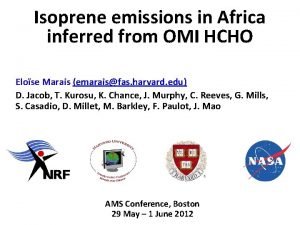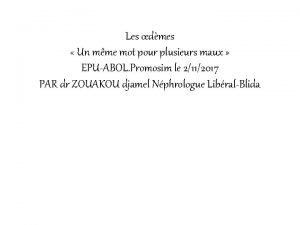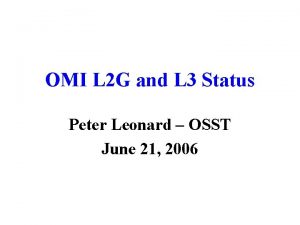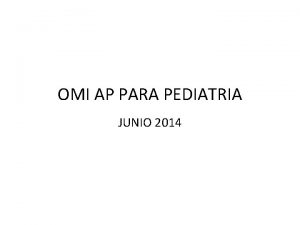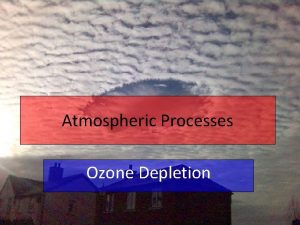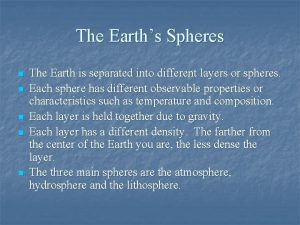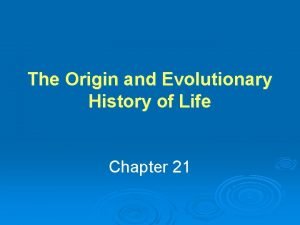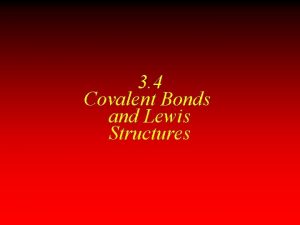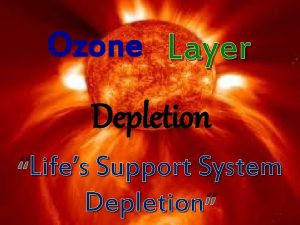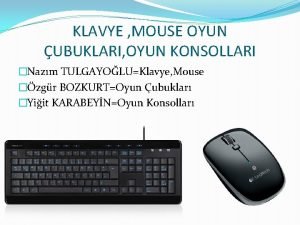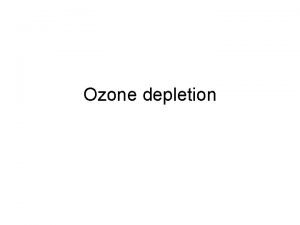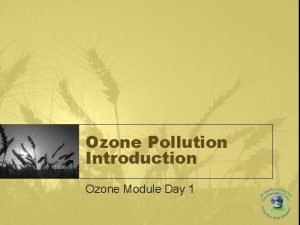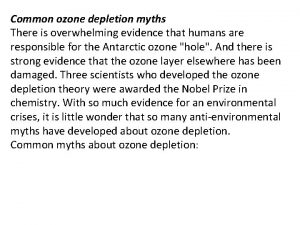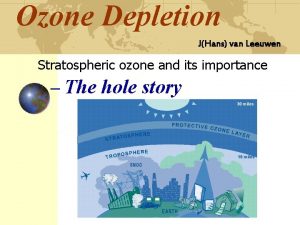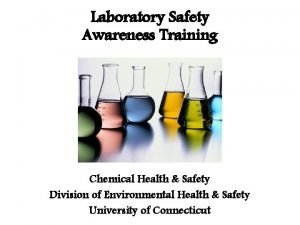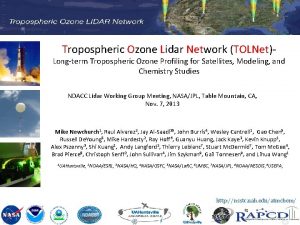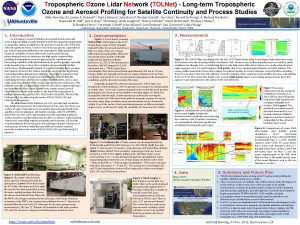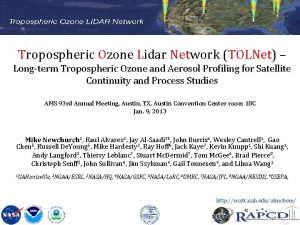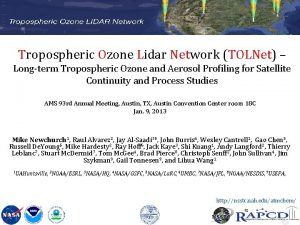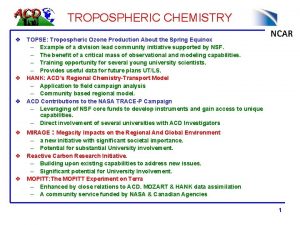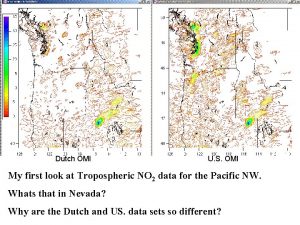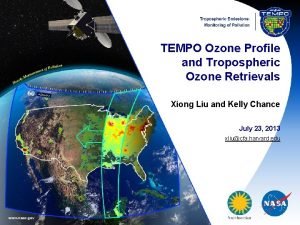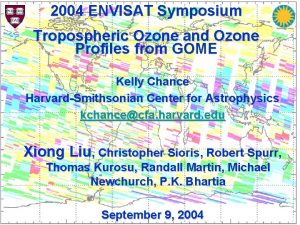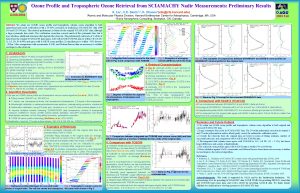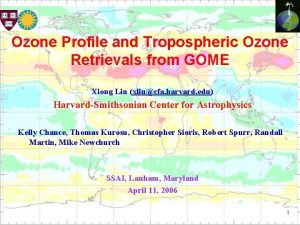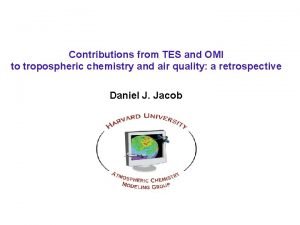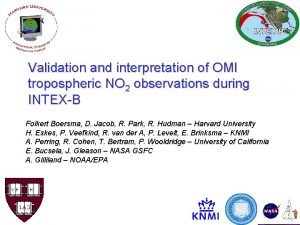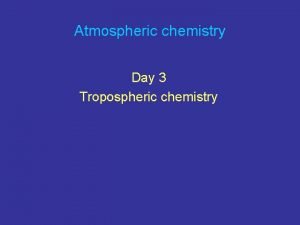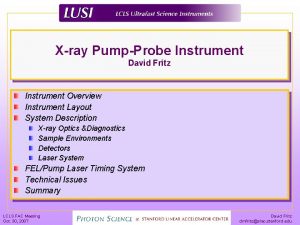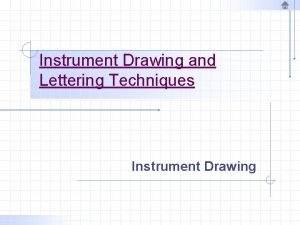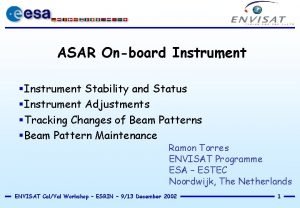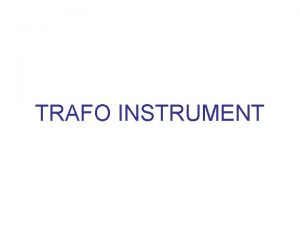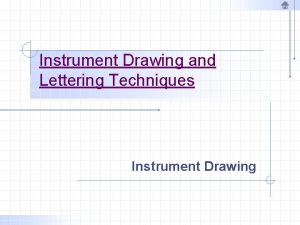Monitoring Tropospheric Ozone from Ozone Monitoring Instrument OMI


![Introduction Backscattered Ultraviolet (BUV) technique [Singer&Wentworth, 1957]: Measure ozone profiles since the 1970 s Introduction Backscattered Ultraviolet (BUV) technique [Singer&Wentworth, 1957]: Measure ozone profiles since the 1970 s](https://slidetodoc.com/presentation_image/4bddc027ddca53b898b15cafc98a8063/image-3.jpg)
![Introduction OMI [Levelt et al. , 2006]: Nadir-viewing UV/Visible instrument (270 -500 nm) Spatial Introduction OMI [Levelt et al. , 2006]: Nadir-viewing UV/Visible instrument (270 -500 nm) Spatial](https://slidetodoc.com/presentation_image/4bddc027ddca53b898b15cafc98a8063/image-4.jpg)















- Slides: 19

Monitoring Tropospheric Ozone from Ozone Monitoring Instrument (OMI) Xiong Liu 1, 2, 3, Pawan K. Bhartia 3, Kelly Chance 2, Thomas P. Kurosu 2, Robert J. D. Spurr 4, Bojan R. Bojkov 1, 3, Ozonesonde Providers xliu@umbc. edu 1 Goddard Earth Sciences and Technology Center, UMBC 2 Harvard-Smithsonian Center for Astrophysics 3 NASA Goddard Space Flight center 4 RT Solutions Inc. 7 th CMAS Conference Chapel Hill, North Carolina, October 7 th, 2008 1

Outline Introduction Retrieval algorithm, information content and retrieval errors Comparison of OMI ozone profiles and stratospheric ozone column with MLS data Comparison of OMI ozone profiles and tropospheric ozone columns with ozonesonde data Examples of retrieved tropospheric ozone Summary Pour Biazar (oral) Wang (poster) Show that the use of OMI ozone profiles as boundary conditions can significantly improve the CMAQ simulations. 2
![Introduction Backscattered Ultraviolet BUV technique SingerWentworth 1957 Measure ozone profiles since the 1970 s Introduction Backscattered Ultraviolet (BUV) technique [Singer&Wentworth, 1957]: Measure ozone profiles since the 1970 s](https://slidetodoc.com/presentation_image/4bddc027ddca53b898b15cafc98a8063/image-3.jpg)
Introduction Backscattered Ultraviolet (BUV) technique [Singer&Wentworth, 1957]: Measure ozone profiles since the 1970 s (BUV, SBUV 2) Provide little information below 25 km [Bhartia et al. , 1996]. Tropospheric O 3 Column (TOC): total O 3 -strat. O 3 column (SOC) Poor spatiotemporal sampling (e. g. , low vertical resolution of nadir sensors and poor horizontal sampling of limb sensors) or large uncertainty in SOC Most methods only derive monthly mean TOC in the tropics With advanced instrumentation (OMI/MLS on AURA) and techniques (e. g. , PV/trajectory mapping, assimilation), possible to derive daily TOC globally [Yang et al. , 2007, Schoeberl et al. , 2007; Stajner et al. , 2007] Tropospheric O 3 retrievals from hyper-spectral UV instruments (e. g. , GOME, OMI) [Chance et al. , 1997, Munro et al. , 1998, Liu et al. , 2005] Strong wavelength dependence of ozone absorption in the Hartley and Huggins bands coupled with wavelength-dependent Rayleigh scattering Temperature dependence in the Huggins bands (313 -340 nm) We developed an 8 -year (July 1995 -June 2003) dataset of GOME ozone profiles and are applying our algorithm to OMI data 3
![Introduction OMI Levelt et al 2006 Nadirviewing UVVisible instrument 270 500 nm Spatial Introduction OMI [Levelt et al. , 2006]: Nadir-viewing UV/Visible instrument (270 -500 nm) Spatial](https://slidetodoc.com/presentation_image/4bddc027ddca53b898b15cafc98a8063/image-4.jpg)
Introduction OMI [Levelt et al. , 2006]: Nadir-viewing UV/Visible instrument (270 -500 nm) Spatial resolution of 13× 24 km 2 at nadir & daily global coverage OMI ozone profile retrieval [Liu et al. , 2005] Retrieve ozone at 24 ~2. 5 -km thick layers from surface to ~60 km using 270 -330 nm radiances Optimal estimation technique [Rodgers, 2000] Use ozone profile climatology by Mcpeters et al. [2007] to constrain retrievals 4

Retrieval Averaging Kernels DFS: 5 -8 with up to 1. 5 -2 in the troposphere. Vertical resolution: ~6 -8 km FWHM in the stratosphere and ~10 km in the troposphere AKs for the bottom layer peak at this altitude. Trop. O 3 info. decreases with latitude and solar zenith angle In practice, due to instrumental calibration error and inadequate forward modeling (e. g. , aerosols, clouds), the information retrieved in the lower troposphere is significantly reduced. 5

Random (N) and Smoothing (S) Errors Random Errors (N): <~2% above 22 km and within ~10% below Smoothing+Random Errors: within 3% between 22 -40 km, increase to 10% above 40 km, and to 20 -30% below 20 km. Errors in O 3 columns (SZA < 85º) Stratospheric O 3 column: 1 -2. 5 DU (N), 2 -5 DU (S+N) Tropospheric O 3 column: 1 -3 DU (N), 2 -6 DU (S+N) Total O 3 column: 0. 3 -2 DU (N), 0. 5 -4 DU (S+N) 6

Comparison with MLS Ozone Profiles MLS: on-board EOS-AURA, spatiotemporally coincident with OMI MLS O 3 error estimate: ~5% in the strat. , ~10 -15% in the lower strat. , ~2 -3% in stratospheric O 3 column [Froidevaux et al. , 2007] OMI agrees well with MLS to within their uncertainties 7

Comp. with MLS 215 h. Pa O 3 Column Mean bias (2006) -0. 65± 2. 75% (-1. 8 ± 7. 6 DU) O 3 column above 215 h. Pa can be accurately derived from OMI data alone !!! 8

Comparison with Ozonesondes Ozonesonde data: available at AURA AVDC for August 2004 -March 12, 2008 Coincidence criteria: within 6 hours, 1º lon. /lat. , cloud fraction (<0. 3) Focus on two latitude bands with enough coincidences: 30ºS-30ºN, 30ºN-60ºN Compare profile and tropospheric O 3 columns (surface-200 mb, surface-~5 km, surface-~2. 5 km) Ozonesonde profiles are convolved with OMI averaging kernels, but not the tropospheric ozone columns 9

Comparison with Ozonesondes (30ºS-30ºN) Solid line: mean Dashed line: 1 Profile: within 10%, significant improvement throughout the troposphere 10

Comparison with Ozonesondes (30ºS-30ºN) Sfc-200 mb: – 0. 3 4. 9 DU, (r=0. 84), slope=0. 73 Sfc-~5 km: – 0. 2 3. 5 DU, (r=0. 76), slope=0. 64 Sfc-~2. 5 km: – 0. 2 2. 4 DU, (r=0. 69), slope=0. 49 11

Comparison with Ozonesondes (30ºN-60ºN) Within 10 -30%, improvement in the middle and upper troposphere. Seasonal dependent biases. 12

Comparison with Ozonesondes (30ºN-60ºN) Winter: 2. 8 7. 9 DU, R = 0. 65 Spring: 2. 9 7. 3 DU, R = 0. 75 Summer: -1. 6 5. 4 DU, R = 0. 79 Fall: 1. 4 5. 2 DU, R = 0. 62 13

First Layer (0 -3 km) Ozone over Southeast Asia Enhanced ozone over Indonesia in Oct. 2006 relative to Oct. 2005. Enhanced ozone over South China especially in Oct. 2006. 14

Column-Averaged O 3 Mixing Ratio (July 15 – September 7, 2006) 15

Summary Stratospheric and tropospheric O 3 columns can be well derived from OMI alone. OMI O 3 profiles and stratospheric O 3 column compare well with MLS, to within combined retrieval uncertainties. OMI O 3 profiles and tropospheric O 3 columns generally compare well with sondes, but show seasonal/lat. /alt. -dependent biases. Retrieved tropospheric ozone can capture some signals due to pollution, biomass burning, regional and intercontinental transport, convection, and stratospheric influence. Our product is currently a reseach product and we plan to make it an operational product. Acknowledgements OMI and MLS Science Teams Support from NASA Support from various organizations on ozonesonde observations 16

“Boundary ozone” (0 -2. 5 km) Ozone over Southeast Asia Enhanced ozone over Indonesia in Oct. 2006 relative to Oct. 2005. Enhanced ozone over South China especially in Oct. 2006. 17

Comparison with Ozonesondes (30ºS-30ºN) 18

Comparison with Ozonesondes (30ºN-60ºN) 19
 Omi burning
Omi burning œdème en pèlerine photos
œdème en pèlerine photos Vex holonomic drive
Vex holonomic drive Omi
Omi Omi.l
Omi.l Omi ap
Omi ap Passive instruments
Passive instruments Sip/aip based monitoring and evaluation instrument tool
Sip/aip based monitoring and evaluation instrument tool Ozone nasa
Ozone nasa Protective ozone layer
Protective ozone layer Vray sun ozone
Vray sun ozone How ozone forms
How ozone forms Ncnh2 lewis structure
Ncnh2 lewis structure Protective ozone layer
Protective ozone layer Ozone klavye
Ozone klavye Ozone layer
Ozone layer Protective ozone layer
Protective ozone layer Ozone hole myth
Ozone hole myth Stratospheric ozone depletion
Stratospheric ozone depletion Ozone hazard symbol
Ozone hazard symbol
